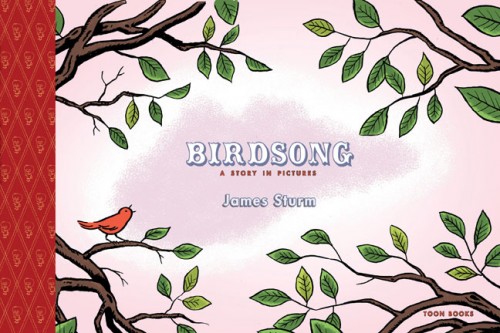
Review: ‘Birdsong’
Birdsong
Writer/artist: James Sturm
Toon Books; $12.95
Level One
Cartoonist James Sturm’s contribution to Toon Books’ line of comics for kids of all ages is, in fact, not a comic book at all.
It is related to the medium though, and is Sturm’s attempt to introduce young readers to the Japanese “paper theater,” an important and influential pre-cursor to comics and animation in Japan, a type of sequential art and, depending on definitions, maybe the first medium to introduce the modern conception of a superhero.
In a perfect example of teaching by showing, Sturm has created a bound, book-format story with no words, just images, which is meant not only to be read, but performed. After the 24 consecutive images that tell the loose story of Birdsong comes a few pages explaining kamishibai/paper theater.
ADVERTISEMENT
ADVERTISEMENT
Let’s start there. As some older fans of manga, anime or pop culture likely already know, kamishibai was a form of cheap, local, street entertainment in Japan during the Great Depression, starting around the 1920s and dwindling out of existence in the post-war years (It was around long enough to have been seen by some children who would grow up to be the first generation of manga artists and Japanese animators). A performer would ride his bicycle into a village, and he would unfold a little stage. A series of illustrations would be placed upon the stage, and the performer would provide narration and dialogue to turn those images into a story for an audience of children, some of whom were there as much for the candy the kamishibai man sold as for the story (As is the case with movie theaters today, the real money is in concessions).
The set-up was reminiscent of a puppet show, but the performance was closer to the reading of a storybook…only here the story existed not as a written text, but in the mind of the performer.
Sturm’s story, therefore, is not only all images and no words, but the connection between the images is loose enough that a reader can make of them what they will. It opens with two children, each clutching a stick, messing with some animals. They flip a turtle on its back, whack a bird and chase it around. It flies to the mouth of a cave, where an old man points a staff at the children, and they are turned into monkeys.
After several trials–a tiger, a band of hunters, time spent in a sideshow–the kids-turned-monkeys are released into the wild and seem to have learned their lesson, living in peace with the very animals they had earlier menaced.
Who are these children, and why are they so mean? Were they both equally mean, or was the little girl just going along with her older brother? (If that even is her older brother, of course.) What’s the deal with the old man, and what is his relationship to the bird? (Note the red feathers he’s adorned with, and the talon motif of his staff). How about the hunters, who have red bird feathers on the shafts of their arrows? What do the children say to one another, and what’s going through their heads?
All of those questions are up to the kamishibai performer, which, in this case, is the reader themselves. The reader can, of course, just read the book, and answer such questions in one’s head, but that’s not really its purpose; it’s meant to be read aloud, to be performed and to be finished by the reader, who here is acting in collaboration with Sturm.
If Sturm is teaching by showing, then he’s encouraging young readers to learn by doing.
There might be other ways to learn about kamishibai, but aside from making your own from scratch, I can’t imagine there’s a more fun and immersive way for young people to do it.
About J. Caleb Mozzocco
J. Caleb Mozzocco is a way-too-busy freelance writer who has written about comics for online and print venues for a rather long time now. He currently contributes to Comic Book Resources' Robot 6 blog and ComicsAlliance, and maintains his own daily-ish blog at EveryDayIsLikeWednesday.blogspot.com. He lives in northeast Ohio, where he works as a circulation clerk at a public library by day.
ADVERTISEMENT
ADVERTISEMENT
SLJ Blog Network
2024 Books from Pura Belpré Winners
In Memorium: The Great Étienne Delessert Passes Away
Parsing Religion in Public Schools
Finding My Own Team Canteen, a cover reveal and guest post by Amalie Jahn
ADVERTISEMENT








